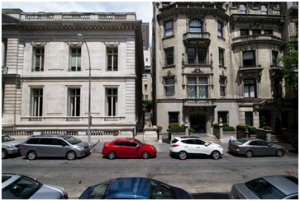
NYU Seeks to Expand Institute of Fine Arts
New York University is currently the largest private university in the United States of America. Occupying more than five districts throughout New York, including its native Greenwich Village the education giant is now looking to expand even further. This time, N.Y.U. is looking to build in the Upper East Side, just a stone’s throw away from Central Park.
 The Institute of Fine Arts building belonging to N.Y.U. was founded in 1958, housing the graduate schools of art history, archaeology and art conservation—the 40,000-square-foot building located at the corner of 5th avenue and 78th Street was donated by Doris Duke, whose father James Duke was a titan in the cigarette industry. The next campus was donated 40 years ago by Sheldon H. Solow who himself dropped out of N.Y.U. but remained fond of it. This is located right beside the first Institute of Fine Arts, now called the Solow Building on 9 West 57th Street.
The Institute of Fine Arts building belonging to N.Y.U. was founded in 1958, housing the graduate schools of art history, archaeology and art conservation—the 40,000-square-foot building located at the corner of 5th avenue and 78th Street was donated by Doris Duke, whose father James Duke was a titan in the cigarette industry. The next campus was donated 40 years ago by Sheldon H. Solow who himself dropped out of N.Y.U. but remained fond of it. This is located right beside the first Institute of Fine Arts, now called the Solow Building on 9 West 57th Street.
Mr. Solow also donated a smaller condo-converted space in 1989, this time 3 East 78th Street. This, today, remains unused because of its size and because there had previously been no need for the University to utilize it. While the school has a lot of campuses, the Institute of Fine Arts was one of the first and is the one which University Administrators feel needs to be enhanced. They are now ready to expand and to move into the donated space. They also want to buy the sunken alley beside it so that they can connect this campus to the Duke Building and the earlier Solow Building. N.Y.U. says that this would be great for their students because it would provide both safety and the cohesion of traditional, bigger campuses.
The Institute of Fine Arts is one of the most successful, renowned—not to mention oldest—colleges at N.Y.U. Back in the 1940s when the University was little more than a commuter school in Manhattan, the school made its name through producing talent and supporting (as well as being supported by) their alumni. In fact, it is a living testament to N.Y.U.’s persistence—Robert Venturi’s first commission was the restoration of the school itself. The school houses 160 students and 40 faculty members. The University hopes that along with their expansion, they can provide room for more students as well as improve the quality of education and the needed facilities for present students. N.Y.U. hopes to have the building up and running in two years. Negotiations to purchase the rest of the building in that lot are also in the works, amounting to a rumored $9 million which University officials say would be well worth it if it meant improving the educational experience of their students. They are now waiting on approval from the members of the neighborhood.
The response of their upscale neighbors has been mixed. While for the most part, the students and faculty—as well as the institution—have mostly had good relations with the people in their neighborhood, some of them have expressed concern over the fact that N.Y.U. wants to buy the back alley behind the buildings. This belongs to the city, according to Mr. Bozzi, a successful Hamptons homebuilder who is loathe to see the small strip of land given to the private institution. Ms. Rubin, an art conservationist, says that she is concerned about the alterations that the University will make to the landscape of the alley itself—a feature of the neighborhood which has been there for decades. David Price, a photographer who has lived across the street from the campus for 35 years argues that the students and faculty are very quiet and are absolutely unobtrusive. Frankly, he says, he is unsure what the fuss is about—as the alley is mostly utilized by N.Y.U. students anyway, he doesn’t see why they can’t buy it: this would mean student safety, not necessarily that other people wouldn’t be allowed on the strip of land. Mr. Price also goes onto say that it’s best that the land goes to N.Y.U., whose goal is furthering the education of its students.
Teri Slater, an N.Y.U. board member says that this expansion project is the future not just of the institution, but of all the students (present and incoming) who will be coming into the city seeking an education in the arts. She pleads with neighbors to look over their proposal, saying that safety and security of both the residents and their students will be taken into consideration. Overall, board members express their excitement over the school’s plans for expansions.
 + 1-888-827-0150
+ 1-888-827-0150 + 44-20-3006-2750
+ 44-20-3006-2750









